Croatia is home to an interesting and rich cuisine with famous dishes that win hearts.
I decided to create a beginner’s guide to Croatian cuisine, so I can explain what food you can find in different regions of Croatia!
Just for the record, some of the food I am about to mention is dangerously delicious, so don’t forget to eat before reading this!
What is Croatian food like?
Croatian food ranges from seafood to meat dishes with lots of vegetables and both the Mediterranean and continental spices popular in Balkan.
What’s awesome about Croatian food is that by traveling through the state you’ll always find something new, usually equally delicious!
I understand that people have preferences, someone falls for seafood, while someone likes plenty of carbs and red meat, but don’t worry there’s something delicious for everyone.
It is possible to categorize Croatian cuisine per region, so I’ll name the most popular dishes you can find and say a few words to describe them.
This way, you’ll know exactly what you are looking for next time you plan a trip here. I’ll start from the sea and coast and then cover the continental region.
Coastline food
Sea and meat dishes can be found along the entire Croatian coastline from Istria to Kvarner and Dalmatia and on the islands, so let’s see what there is!
Buzara
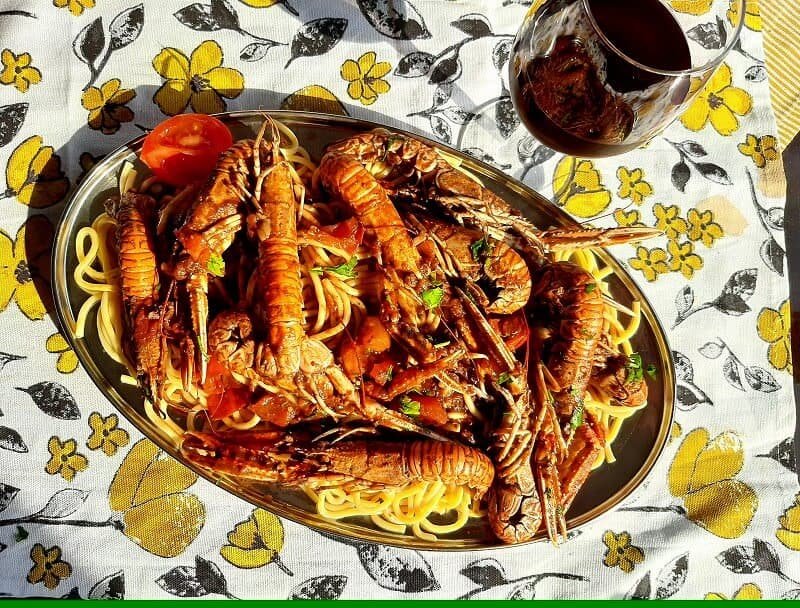
Buzara is traditionally made from prawns, but it’s not unusual to find Buzara made from mussels and shrimp.
This famous sea dish is super simple yet fresh seafood is necessary. Prawns, olive oil, garlic, tomato, and wine is all you need to make the buzara worthy of the kings.
I won’t ever forget the smell this dish makes in the kitchen, as when I first discovered it as a child I would intentionally spend time in the kitchen just enjoying the wonderful smells in anticipation before I could put my hands on it.
Forget about the fork and a knife, true buzara is enjoyed bear handed as you’ll need to reach the meat between the shells. You’ll be served some warm water with lemon juice to wash your hands afterward, don’t worry!
Buzara is enjoyed for its amazing and fancy flavors, but with enough carbs such as pasta, you won’t end up hungry.
Brudet
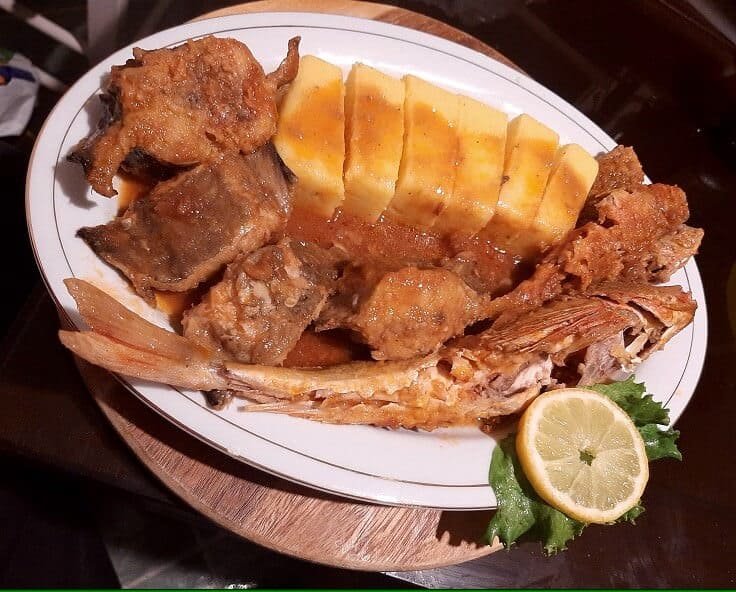
There is a saying, a good brudet is measured by how many fish varieties are in it.
Brudet is always made from various fish such as conger eel, scorpionfishes, and sharks and served with carbs such as polenta (cro. palenta), or pasta and potatoes in the lack of polenta.
A traditional way to serve brudet is with polenta, the corn flour porridge. Pair it with some green salad and white wine and you have the sea dish you won’t forget for a lifetime.
It’s possible that you won’t eat the same brudet twice, as there are so many possibilities when it comes to tweaking the recipe, but it’s so tasty that you’ll enjoy it every time as long as the cooks are not cheap on fish.
Brudet is one of those dishes that win your heart and engrave the good memories in your mind of spending time by the coastline or on islands of the mediterranean sea.
Gradele

Gradele dish is any fish or vegetables traditionally prepared on a grill.
Gradele is a traditional Croatian method of cooking and you’ll find many lovely dishes made this way.
What makes this grill special is the process and ingredients used.
First, the fish is put on a grill placed above the embers, then for the whole duration of grilling the fish is oiled with extra virgin olive oil and parsley.
Once the fish is cooked, more olive oil, garlic, parsley, salt, and pepper are added.
Traditionally, Gradele is always enjoyed with fine wine which makes the experience complete.
The fish swims 3 times, once in the sea, second in the oil, and third time in the wine.
The old Dalmatian saying
Crni rižot (Black risotto)

Crni rižot is a sea dish prepared with squid and rice, typically served with a salad and white wine.
This delicious dish doesn’t only taste different than any other sea dish but also looks completely different and somewhat extravagant.
The black color comes from squid ink, but it’s not just about the color, the squid ink provides a beautiful texture to the rice and a strong aroma.
If you are looking to try something different you never tried before, put crni rižot on the list.
Salata od hobotnice (Octopus salad)

Octopus salad is a delicious dish made from cooked octopus chopped into small pieces, potato, onions, parsley, olive oil, and seasoned with salt, pepper, and lemon juice.
This dish is enjoyed cold and served as an appetizer or a light dish that won’t overwhelm you while it will reveal the rich cuisine of Croatian coastal areas.
Although I love Octopus salad, in my opinion, the Octopus under the bell is the epitome of Croatian coastline cuisine as that perfection can hardly be beaten.
Jela ispod peke (food under the bell)
Jela ispod peke is a traditional Croatian method of preparing delicious dishes by cooking in a bell-shaped dome surrounded by a bed of hot coals and wood.
This way, the temperature can get extremely hot and the meat and vegetables will be cooked evenly and infused with smoky flavors during slow cooking which can take several hours.

Jela ispod peke consists of various types of meat such as lamb, beef, and veal, seafood like monkfish and octopus, and vegetables, while it is common to season dishes with herbs like thyme, rosemary, garlic, and onions.
Moreover, it’s also common to find traditional Dalmatian bread prepared under the bell.
My favorite dish under the bell is the lamb with potatoes, and vegetables such as onions and carrots, and I can vouch that no quick, restaurant cooking methods will result in such evenly cooked, smoked, and juicy meat as when it’s cooked under the bell.
When I was young I used to participate in big family gatherings around Peka, and while it always takes hours for Peka to be done, it was worth it every time.
Jela ispod peke isn’t an everyday thing in restaurants but rather a specialty only some restaurants offer, so if you catch the opportunity to try Jela ispod peke don’t miss it!
Pršut (Croatian prosciutto)
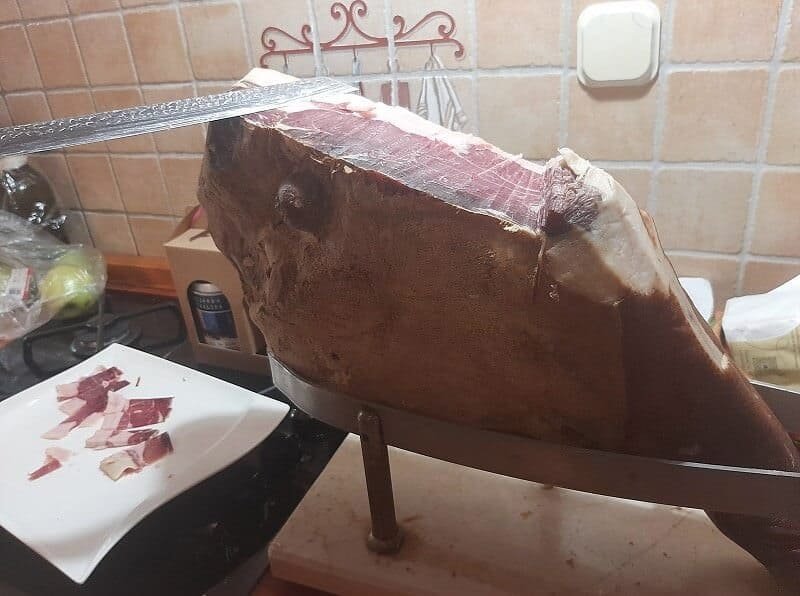
If you are a fan of pršut, you’ll find Croatian pršut among the best you ever had.
While many claim there’s no pršut like Dalmatinski anywhere else in the world, many also praise the Istrian pršut and for the politeness, I must give a shoutout to the Italian prosciutto too.
Let’s begin with the Dalmation pršut, you’ll know what makes it special after taking the first bite as the smokey flavors trapped within a great balance of dried meat and fat will dissolve on your palate.
Damaltinski pršut is unique because only the high-quality meat along with the skin and fat is salted, then dried on the notorious Croatian wind called bura for 2 months, smoked for 2 months, and eventually aged for at least 12 months to produce the unique masterpiece of Dalmatian cuisine.
Istarski pršut on other hand isn’t made with skin and fat and the smoking part is excluded.
Nevertheless, it tastes amazing and has similarities with Italian pršut.
There are also Krčki pršuti (from the island of Krk) which fall somewhere between Dalmatian and Istrian styles and all named pršuti are registered as indigenous national products.
Every pršut unique to the region tastes different and has its own perks, so the point of the story is that if you like dry, salty pršut with a strong smokey flavor the greatest type of such pršut is found in Dalmatia but sweeter, less smokey variations can be found elsewhere such in Istria or Krk.
Creska janjetina (Cres Lamb Dish)

If there is one iconic dish I could highlight that origins from the Kvarner area I’d pick out the one and only, Creska janjetina.
This dish is prepared on the island of Cres, and due to the fact that it’s super easy to visit Cres from Rijeka, this dish is absolutely unavoidable.
Creska janjetina is a favorite among the locals, as it’s easy to spot the quality of the Croatian lamb from the lamb that is mass-produced in countries such as New Zealand or other states it gets exported from.
It’s said that the lambs that populate the island of Cres, enjoy the variety of vegetables that are found in the preserved nature far away from the influence of dirt, and air pollution.
After all, Cres is home to around 1100 plants, with 939 indigenous species that enrich the land like nowhere else.
It is said that there are more plant varieties found in Cres than on all lands of the UK combined.
Thus, the lamb from the Cres region tastes so juicy and sweet with unique aromas you couldn’t notice in other lamb meat.
The typical lamb dish is made from lamb, potatoes, onion, garlic, and salt but it’s not unusual to find other grilled or cooked vegetables in it.
When you only need salt from all the seasoning options to produce excellent, mouth-watering meat you know it’s something special.
Istarski fuži with boškarin and truffels
Here, I’ll focus on a famous dish that Istria is known for and as a matter of fact, this dish was the reason why I’d often travel to Istria back in the day.
Then, I learned to prepare this dish at home, so I no longer have to travel miles just to enjoy this heavenly dish.
The dish is made with Istrian pasta called fuži, which is pasta cut from a thin layer of dough in a diamond shape.
This pasta is worth comparing with other famous Italian kinds of pasta and the best of all is that fuži are freshly made in restaurants or at household instead of buying dried pasta in bulk which adds to the quality of the dish.
This alone, makes a huge difference and Istrian restaurants are keeping this tradition strong for a very long time.
Istria is rich with the finest black truffles in Europe, and when truffles are mixed with fuži, olive oil, and cheese, there are hardly any words I could use to explain the experience.
Moreover, you can also enjoy fuži with Boškarin, the cattle authentic to the region of Istria.
Boškarin can be prepared in many dishes and even in a classic salami, and it’s usually followed with spicy black pepper.
At one point in time, Boškarin was close to extinction and while it’s being populated back again, this dish is still for a reason only found in Istria which creates a certain rarity that makes Istrian cuisine special.
Istrian Maneštra (Istrian vegetable stew)
Istrian Maneštra is a traditional stew made with beans, potatoes, various vegetables, and smoked ham or bacon.
This famous Istrian stew is slow-cooked for several hours before all the flavors meld together and produce a worthy dish of the region.
Istrian Maneštra is enjoyed with locally-made crusty bread and a glass of red wine.
While this dish is ideal for cooler weather, I don’t ever say no when someone offers me some.
Continental Food
Čvarci
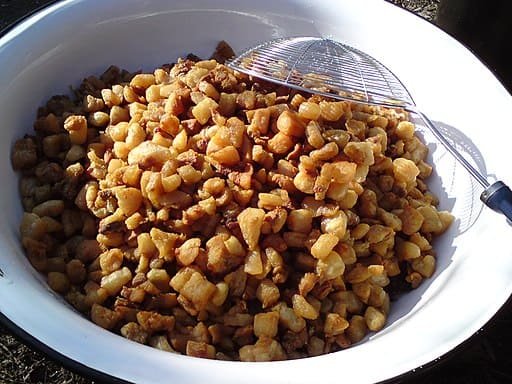
Čvarci are fried pork scratchings, and while this used to be the food of peasants hundred years ago, today it’s a sophisticated delicacy in the area of Continental Croatia.
Čvarci are great snacks and taste amazing, but they are pretty much pure fat which translates to lots of calories, so be careful not to get addicted!
For some reason, the taste of fried pork fat is hard to resist unless you are a vegan, of course.
Meso z Tiblice
This popular dish Meso z Tiblice, Međimurje is renowned for, is the fine pork meat seasoned and baked and then set in plenty of pork fat.
This dish originated as an answer to the lack of refrigerators back in the day when people would need to preserve food over the year.
One good way to preserve the meat is to put it in salt and dry it on the strong wind as it’s the case with pršut and many sausages, but the other is to trap the meat in so much fat that no contaminants could touch it.
Today, Meso z’ Tiblice is served as an appetizer when you visit Međimurje.
Bučnica (pumpkin pie)
Who can resist a pumpkin pie? I know I can’t and that’s why I can’t wait for autumn to finally arrive.
A few eggs in, some cottage cheese, butter, seasoning, cream, and pumpkin stuffed in dough can’t be resisted.
Bucnica smells just as good as it tastes and its coziness shall welcome any foreigner to Zagorje.
Bucnica is just one of the many pumpkin dishes, I personally also love pumpkin soup.
Purica s mlincima (turkey with flatbread)
Purica s mlincima will evoke emotions Americans hold on a Thanksgiving as it’s pretty similar to it but is prepared in a different, traditional way.
While you’ll find purica (turkey) to be prepared in a similar fashion as you’d find in other cuisines, mlinci are something unique to Croatia.
Mlinci is a thin, dried dough made of flour, salt, and water which are later poured over with boiling water and meat juice.
The result is an untypical, juice pasta with an interesting texture that melts in the mouth.
Purica s mlincima is served everywhere in Croatia during holidays but is an especially popular dish in continental Croatia.
Slavonski Čobanac
Made from at least 3 types of meat such as beef, pork, and chicken with some vegetables and noticeable addition of spices such as strong, red paprika (consider this something close to chili as it’s similarly spicy).
Slavonski Čobanac is traditionally cooked outside in a big kettle that can hold gallons as a dish that takes more than 3 hours to complete isn’t worth making in small quantities.
Slavonski Čobanac is a traditional dish that would be prepared for big families and guests on special occasions and then people would proceed to enjoy wine and play traditional instruments such as tamburica and harmonika.
This is a phenomenal dish you can’t miss if you ever pay Slavonija a visit!
Fiš paprikaš
Fiš paprikaš is a delicious dish made from at least 2 types of freshwater fish such as catfish and carp, Slavonian dry red paprika, and wine served with noodles.
This dish can be bitter and sweet, full of glorious aroma, and nutritious.
Fiš paprikaš is among my favorite continental Croatian dishes and it goes so well with local white wine, so if you are keen on freshwater fish dishes give it a try.
Kulen (spicy sausage)
They call it the King of all Croatian sausages, the one and only, Slavonian Kulen.
Kulen is a smoked, spicy pork sausage known for its strong and distinctive red color and spicy, meaty taste with plenty of influence of red paprika and garlic.
Kulen is a very clean sausage made from quality meat and it takes lots of finesse to produce such a masterful sausage.
Slavonia is full of rich and flavorful food products and dishes and if you are a fan of sausages you can’t miss it.
Popular croatian desserts
Fritule (sweet pastry balls)

Fritula, the sweet pastry balls made from flour, eggs, sugar, milk, raisins, and sometimes an addition of rakija or rum for flavor are the ideal street-food treats.
Fritula is fried in hot oil until they become golden brown, then is dusted with powdered sugar and served warm.
Fritula is a popular treat during the holiday season, particularly around Carnival Time and Christmas when you can find them at every corner in Croatian towns.
However, there are no rules that forbid eating them during the rest of the seasons!
Kremšnita (Cream slice)
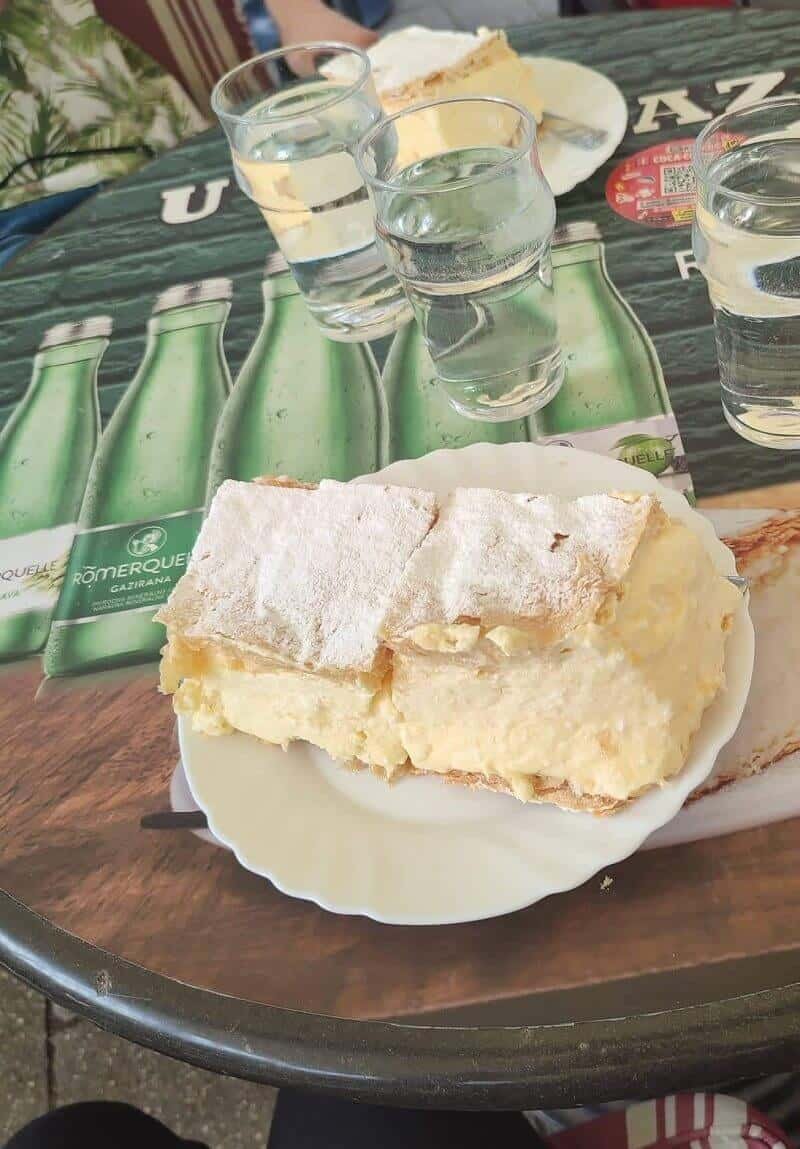
Kremšnita is a traditional Croatian pastry dessert that originated in the town of Samobor.
Whenever I travel to Zagreb I stop on the way to Samobor to enjoy Kremšnita and mead.
Kremšnita is made from two layers of puff pastry filled with vanilla cream custard and whipped cream.
There are variations to the original recipe, but what recipes have in common is the baked layers of pastry which become golden and then powdered with sugar while inside is the thick layer of vanilla cream custard and whipped cream that makes you want to eat more and more.
While you’ll find many variations of Kremšnita, I recommend the original Samobor Kremšnita because it’s simply outstanding.
Samobor Kremšnita is soft, puffy, and refreshing while some other variations tend to contain gelatine and trade the puffiness for more thick texture and dominant vanilla custard flavor.
Štrukli (cheese and pastry dish)

Štrukli is made from sweet dough filled with cheese baked in the oven and must be a real delicacy for all of you with a sweet tooth.
The caramelized dough topping and inside of creamy, soft cheese followed by the glass of milk require no further explanation.
You’ll find great Štrukli in Zagorje, especially if you have the privilege to eat in someone’s grandma’s kitchen.
Croatia has a variety of great sweet traditional food, but if I were to mention everything in one article, You’d never leave this website.
Similarities with Italian cuisine
Croatian cuisine by the coast has similarities with Italian cuisine. For instance, you’ll notice that olive oil is used as the primary choice for many dishes, Parmigiano Reggiano is among the most popular cheeses, Italian pasta recipes are a common launch in households, and herbs such as basil, oregano, rosemary, sage, and thyme are grown and used in Croatian cuisine just as these spices are a norm for Italian cuisine.
As you can see, the Mediterranean influence is strong in both cuisines and has been in the culture for centuries which shouldn’t surprise.
You can enjoy one style of food similar to Italian cuisine by the coast and then by traveling only for a few miles towards the continent, you’ll find completely the opposite cuisine that has nothing in common with what you tried before.
Similarities with Turkish cuisine
Although more prevalent in continental Croatia, there’s some influence from Turkish cuisine in Croatia.
We are talking about literal recipes that originate from Turkey that aren’t a normal part of a tradition in Croatian cuisine but got accepted over time.
I didn’t mention these dishes in the list above because they are not considered indigenous Croatian dishes, but you can find those dishes in many places whether it’s a restaurant or fast food!
All of these recipes came to Croatia from Bosnia, as Bosnia was under the Ottoman empire for centuries, so lots of modern Turkish cuisine, traditions, and even language can still be found in the region of Balkan.
Although the Ottoman empire never conquered Croatia, its influence was nevertheless strong.
Thus, you’ll find phenomenal dishes such as popular meat pies called “burek”, and other pie variants stuffed with vegetables, butter, and honey. “Cevapi” and “Sarma” probably also pull the strings from Turkish cuisine but over time, the dishes would get accepted and then the domestic cuisine would get inspired and create similar dishes from one influence.
Some people would argue that none of the mentioned food such as Cevapi, Sarma, and Burek should be called Croatian food due to their roots that come from Bosnia, however, getting into such arguments could easily become overwhelming as in Bosnia live Bosnian Muslims and Croatian and Serbian Christians.
Thus, so many cultures and traditions got entangled and created a lively and rich cuisine!
It’s not unusual for people from Croatia to have grandmas and cousins all across the state or in nearby states such as Bosnia, Slovenia, or Serbia, so the recipes and cooking methods are shared across the state.
